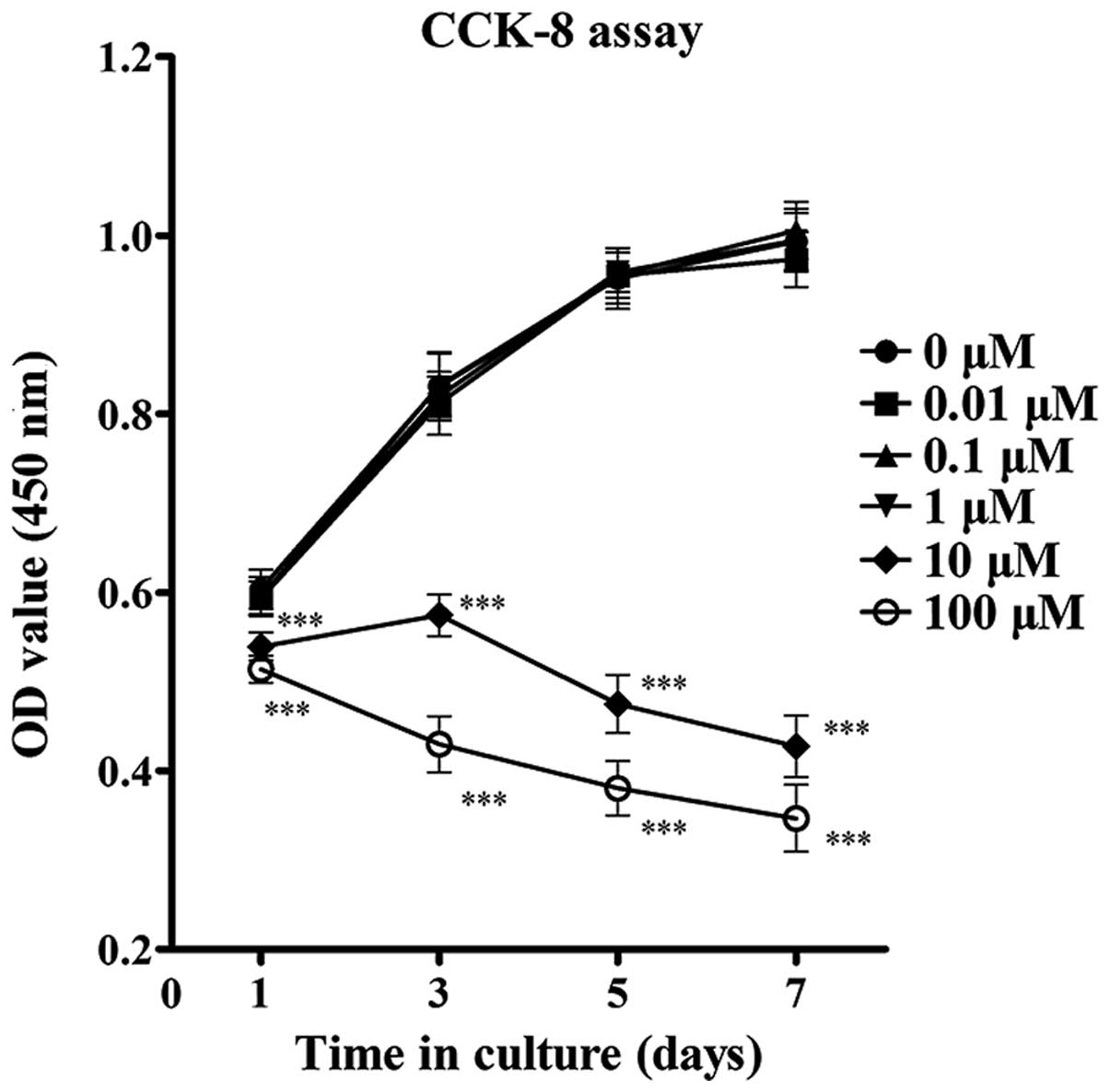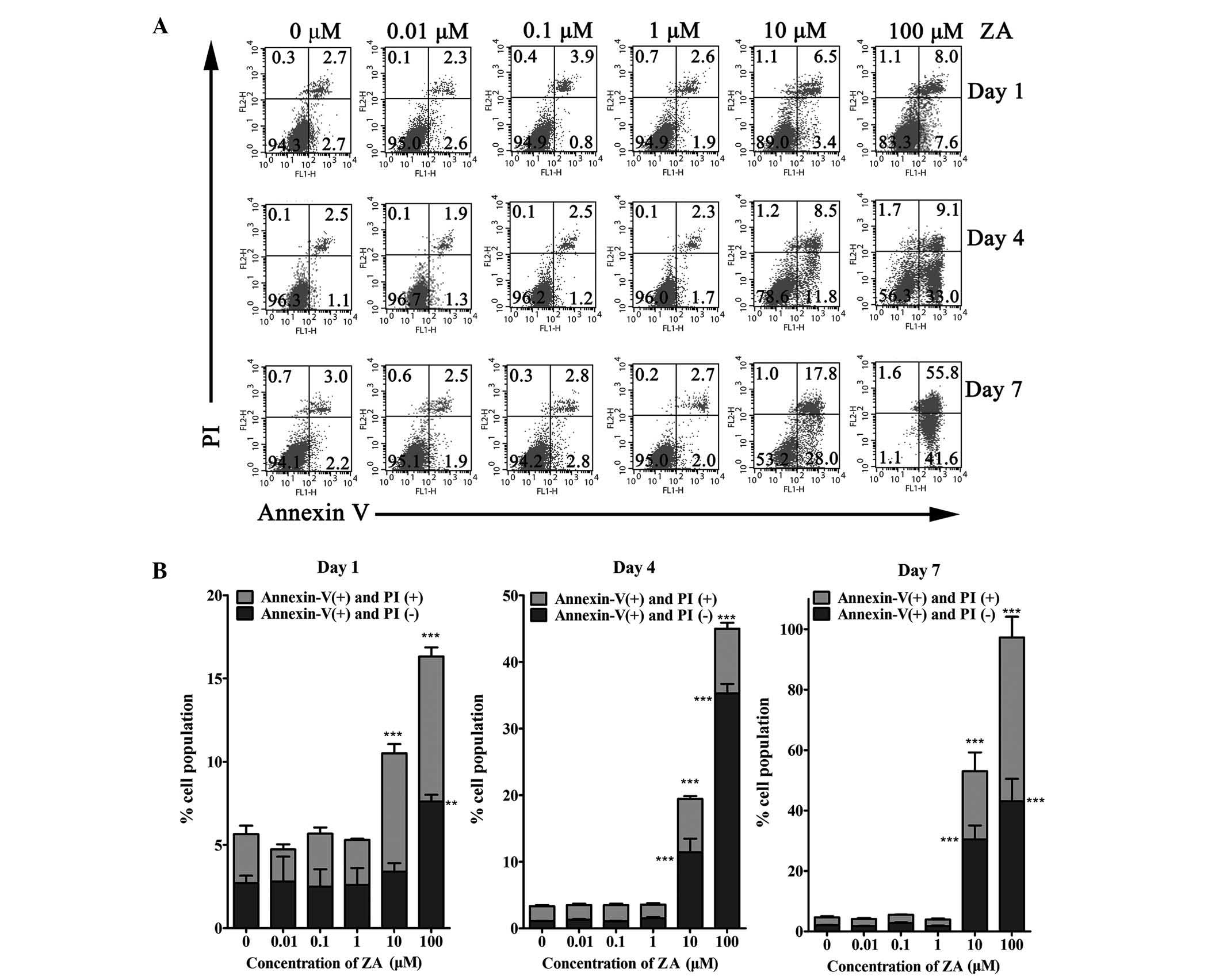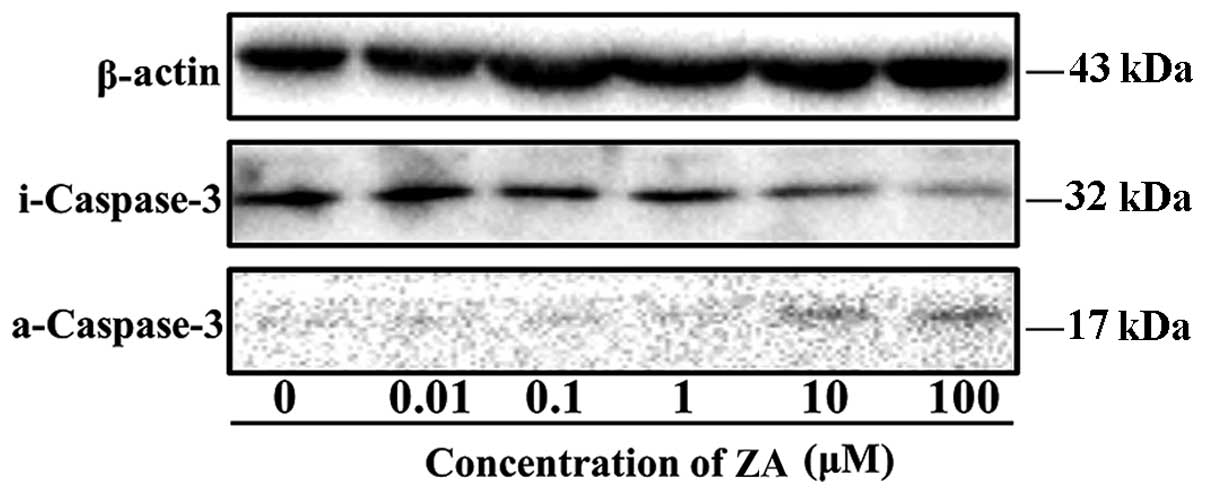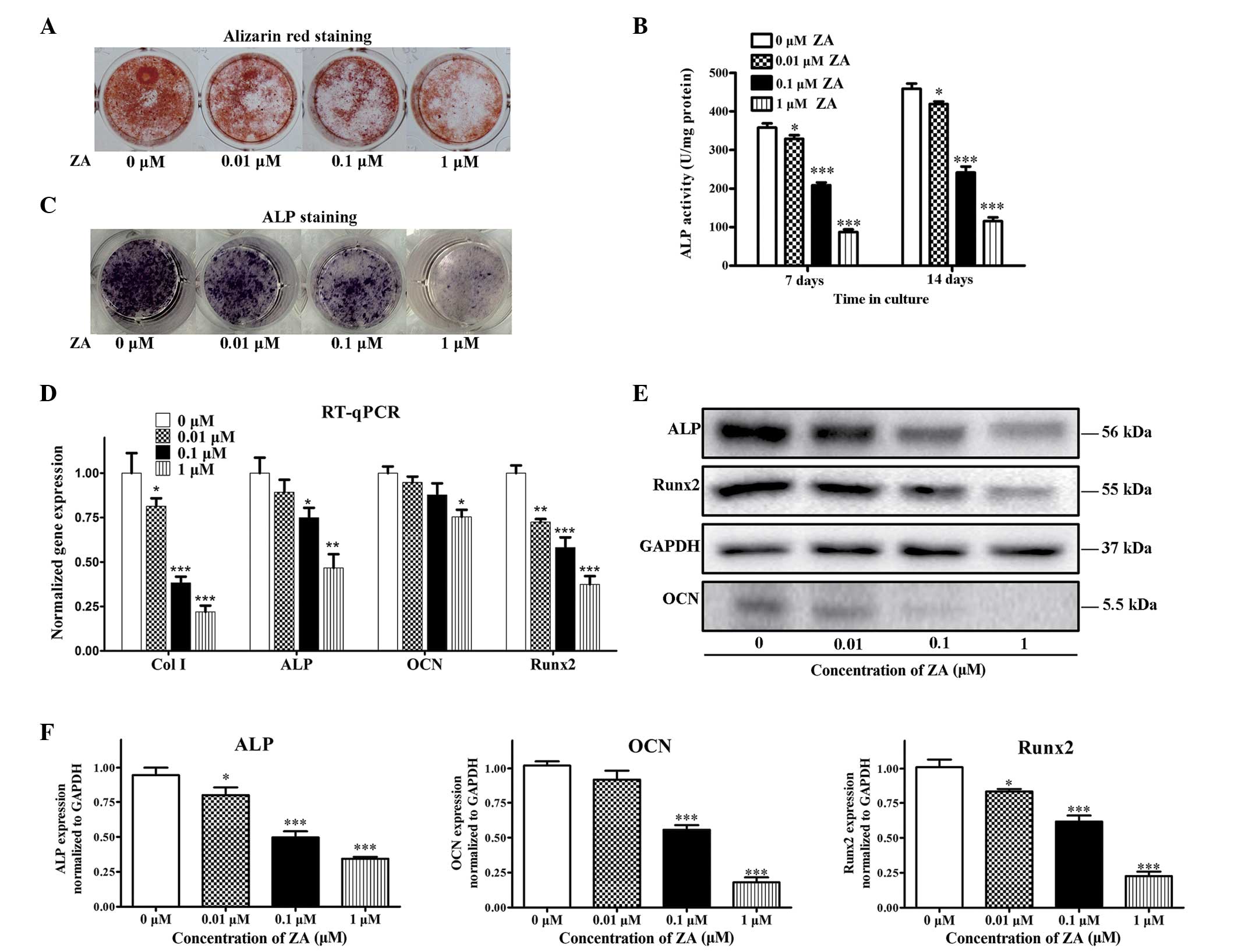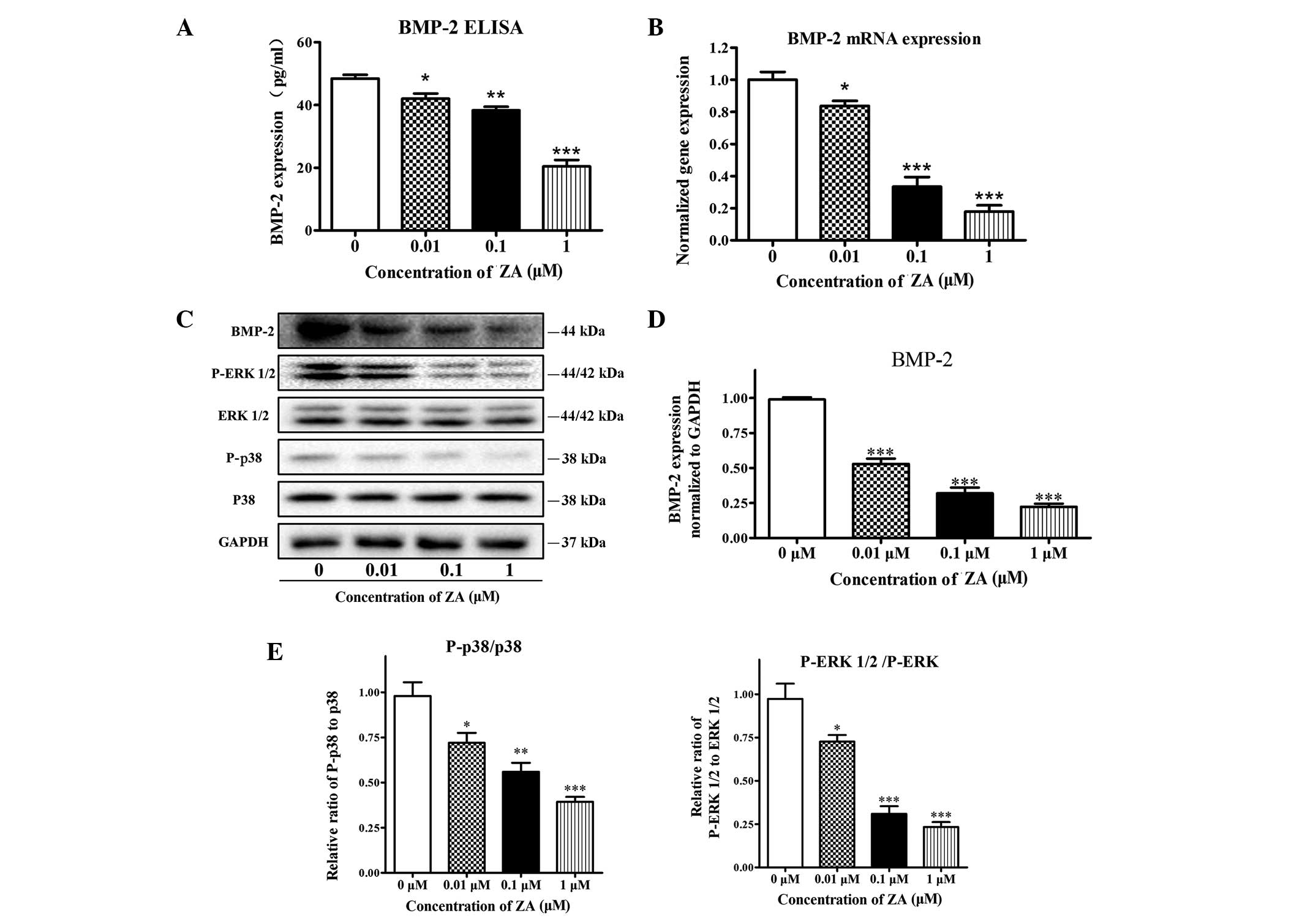|
1
|
Bone HG, Hosking D, Devogelaer JP, Tucci
JR, Emkey RD, Tonino RP, Rodriguez-Portales JA, Downs RW, Gupta J,
Santora AC, et al: Ten years' experience with alendronate for
osteoporosis in postmenopausal women. N Engl J Med. 350:1189–1199.
2004. View Article : Google Scholar : PubMed/NCBI
|
|
2
|
Aapro M, Abrahamsson PA, Body JJ, Coleman
RE, Colomer R, Costa L, Crinò L, Dirix L, Gnant M, Gralow J, et al:
Guidance on the use of bisphosphonates in solid tumours:
recommendations of an international expert panel. Ann Oncol.
19:420–432. 2008. View Article : Google Scholar
|
|
3
|
Russell RG: Bisphosphonates: mode of
action and pharmacology. Pediatrics. 119(Suppl 2): S150–S162. 2007.
View Article : Google Scholar : PubMed/NCBI
|
|
4
|
Dunford JE, Rogers MJ, Ebetino FH, Phipps
RJ and Coxon FP: Inhibition of protein prenylation by
bisphosphonates causes sustained activation of Rac, Cdc42 and Rho
GTPases. J Bone Miner Res. 21:684–694. 2006. View Article : Google Scholar : PubMed/NCBI
|
|
5
|
Lawson MA, Xia Z, Barnett BL, Triffitt JT,
Phipps RJ, Dunford JE, Locklin RM, Ebetino FH and Russell RG:
Differences between bisphosphonates in binding affinities for
hydroxyapatite. J Biomed Mater Res B Appl Biomater. 92:149–155.
2010. View Article : Google Scholar
|
|
6
|
Vestergaard P, Schwartz K, Pinholt EM,
Rejnmark L and Mosekilde L: Gastric and esophagus events before and
during treatment of osteoporosis. Calcif Tissue Int. 86:110–115.
2010. View Article : Google Scholar
|
|
7
|
Coleman R, Burkinshaw R, Winter M,
Neville-Webbe H, Lestera J, Woodward E and Brown J: Zoledronic
acid. Expert Opin Drug Saf. 10:133–145. 2011. View Article : Google Scholar
|
|
8
|
Marx RE: Pamidronate (Aredia) and
zoledronate (Zometa) induced avascular necrosis of the jaws: A
growing epidemic. J Oral Maxillofac Surg. 61:1115–1117. 2003.
View Article : Google Scholar : PubMed/NCBI
|
|
9
|
Ruggiero SL: Bisphosphonate-related
osteonecrosis of the jaw: an overview. Ann N Y Acad Sci.
1218:38–46. 2011. View Article : Google Scholar
|
|
10
|
Ruggiero SL, Dodson TB, Assael LA,
Landesberg R, Marx RE and Mehrotra B; American Association of Oral
and Maxillofacial Surgeons: American Association of Oral and
Maxillofacial Surgeons position paper on bisphosphonate-related
osteonecrosis of the jaws - 2009 update. J Oral Maxillofac Surg.
67:2–12. 2009.PubMed/NCBI
|
|
11
|
Diel IJ, Fogelman I, Al-Nawas B,
Hoffmeister B, Migliorati C, Gligorov J, Väänänen K, Pylkkänen L,
Pecherstorfer M and Aapro MS: Pathophysiology, risk factors and
management of bisphosphonate-associated osteonecrosis of the jaw:
Is there a diverse relationship of amino- and
non-aminobisphosphonates? Crit Rev Oncol Hematol. 64:198–207. 2007.
View Article : Google Scholar : PubMed/NCBI
|
|
12
|
Huja SS, Fernandez SA, Phillips C and Li
Y: Zoledronic acid decreases bone formation without causing
osteocyte death in mice. Arch Oral Biol. 54:851–856. 2009.
View Article : Google Scholar : PubMed/NCBI
|
|
13
|
Pozzi S, Vallet S, Mukherjee S, Cirstea D,
Vaghela N, Santo L, Rosen E, Ikeda H, Okawa Y, Kiziltepe T and
Schoonmaker J: High-dose zoledronic acid impacts bone remodeling
with effects on osteoblastic lineage and bone mechanical
properties. Clin Cancer Res. 15:5829–5839. 2009. View Article : Google Scholar : PubMed/NCBI
|
|
14
|
Bragdon B, Moseychuk O, Saldanha S, King
D, Julian J and Nohe A: Bone morphogenetic proteins: a critical
review. Cell Signal. 23:609–620. 2011. View Article : Google Scholar
|
|
15
|
Ten DP, Fu J, Schaap P and Roelen BA:
Signal transduction of bone morphogenetic proteins in osteoblast
differentiation. J Bone Joint Surg Am. 85-A(Suppl 3): 34–38.
2003.
|
|
16
|
Chen G, Deng C and Li YP: TGF-β and BMP
signaling in osteoblast differentiation and bone formation. Int J
Biol Sci. 8:272–288. 2012. View Article : Google Scholar
|
|
17
|
Hu Y, Chan E, Wang SX and Li B: Activation
of p38 mitogen-activated protein kinase is required for osteoblast
differentiation. Endocrinology. 144:2068–2074. 2003. View Article : Google Scholar : PubMed/NCBI
|
|
18
|
Guicheux J, Lemonnier J, Ghayor C, Suzuki
A, Palmer G and Caverzasio J: Activation of p38 mitogen-activated
protein kinase and c-Jun-NH2-terminal kinase by BMP-2 and their
implication in the stimulation of osteoblastic cell
differentiation. J Bone Miner Res. 18:2060–2068. 2003. View Article : Google Scholar : PubMed/NCBI
|
|
19
|
Jadlowiec J, Koch H, Zhang X, Campbell PG,
Seyedain M and Sfeir C: Phosphophoryn regulates the gene expression
and differentiation of NIH3T3, MC3T3-E1 and human mesenchymal stem
cells via the integrin/MAPK signaling pathway. J Biol Chem.
279:53323–53330. 2004. View Article : Google Scholar : PubMed/NCBI
|
|
20
|
Nohe A, Keating E, Knaus P and Petersen
NO: Signal transduction of bone morphogenetic protein receptors.
Cell Signal. 16:291–299. 2004. View Article : Google Scholar
|
|
21
|
Ducy P, Zhang R, Geoffroy V, Ridall AL and
Karsenty G: Osf2/Cbfa1: A transcriptional activator of osteoblast
differentiation. Cell. 89:747–754. 1997. View Article : Google Scholar : PubMed/NCBI
|
|
22
|
Scheper MA, Badros A, Salama AR, Warburton
G, Cullen KJ, Weikel DS and Meiller TF: A novel bioassay model to
determine clinically significant bisphosphonate levels. Support
Care Cancer. 17:1553–1557. 2009. View Article : Google Scholar : PubMed/NCBI
|
|
23
|
von Knoch F, Jaquiery C, Kowalsky M,
Schaeren S, Alabre C, Martin I, Rubash HE and Shanbhag AS: Effects
of bisphos-phonates on proliferation and osteoblast differentiation
of human bone marrow stromal cells. Biomaterials. 26:6941–6949.
2005. View Article : Google Scholar : PubMed/NCBI
|
|
24
|
Pan B, Farrugia AN, To LB, Findlay DM,
Green J, Lynch K and Zannettino AC: The nitrogen-containing
bisphosphonate, zoledronic acid, influences RANKL expression in
human osteoblast-like cells by activating TNF-alpha converting
enzyme (TACE). J Bone Miner Res. 19:147–154. 2004. View Article : Google Scholar : PubMed/NCBI
|
|
25
|
Schindeler A and Little DG: Osteoclasts
but not osteoblasts are affected by a calcified surface treated
with zoledronic acid. in vitro Biochem Biophys Res Commun.
338:710–716. 2005. View Article : Google Scholar
|
|
26
|
Sudo H, Kodama HA, Amagai Y, Yamamoto S
and Kasai S: In vitro differentiation and calcification in a new
clonal osteogenic cell line derived from newborn mouse calvaria. J
Cell Biol. 96:191–198. 1983. View Article : Google Scholar : PubMed/NCBI
|
|
27
|
Schmittgen TD and Livak KJ: Analyzing
real-time PCR data by the comparative C(T) method. Nat Protoc.
3:1101–1108. 2008. View Article : Google Scholar : PubMed/NCBI
|
|
28
|
Ding WX, Ni HM, DiFrancesca D, Stolz DB
and Yin XM: Bid-dependent generation of oxygen radicals promotes
death receptor activation-induced apoptosis in murine hepatocytes.
Hepatology. 40:403–413. 2004. View Article : Google Scholar : PubMed/NCBI
|
|
29
|
Niu YB, Li YH, Kong XH, Zhang R, Sun Y, Li
Q, Li C, Liu L, Wang J and Mei QB: The beneficial effect of Radix
Dipsaci total saponins on bone metabolism in vitro and in vivo and
the possible mechanisms of action. Osteoporos Int. 23:2649–2660.
2012. View Article : Google Scholar : PubMed/NCBI
|
|
30
|
Allen MR and Burr DB: Mandible matrix
necrosis in beagle dogs after 3 years of daily oral bisphosphonate
treatment. J Oral Maxillofac Surg. 66:987–994. 2008. View Article : Google Scholar : PubMed/NCBI
|
|
31
|
Stresing V, Fournier PG, Bellahcene A,
Benzaïd I, Mönkkönen H, Colombel M, Ebetino FH, Castronovo V and
Clézardin P: Nitrogen-containing bisphosphonates can inhibit
angiogenesis in vivo without the involvement of farnesyl
pyrophosphate synthase. Bone. 48:259–266. 2011. View Article : Google Scholar
|
|
32
|
Naik NH and Russo TA:
Bisphosphonate-related osteonecrosis of the jaw: the role of
actinomyces. Clin Infect Dis. 49:1729–1732. 2009. View Article : Google Scholar : PubMed/NCBI
|
|
33
|
Kuhl S, Walter C, Acham S, Pfeffer R and
Lambrecht JT: Bisphosphonate-related osteonecrosis of the jaws-a
review. Oral Oncol. 48:938–947. 2012. View Article : Google Scholar
|
|
34
|
Hoff AO, Toth BB, Altundag K, Johnson MM,
Warneke CL, Hu M, Nooka A, Sayegh G, Guarneri V, Desrouleaux K, et
al: Frequency and risk factors associated with osteonecrosis of the
jaw in cancer patients treated with intravenous bisphosphonates. J
Bone Miner Res. 23:826–836. 2008. View Article : Google Scholar : PubMed/NCBI
|
|
35
|
Raje N, Woo SB, Hande K, Yap JT,
Richardson PG, Vallet S, Treister N, Hideshima T, Sheehy N, Chhetri
S, et al: Clinical, radiographic and biochemical characterization
of multiple myeloma patients with osteonecrosis of the jaw. Clin
Cancer Res. 14:2387–2395. 2008. View Article : Google Scholar : PubMed/NCBI
|
|
36
|
Recker RR, Delmas PD, Halse J, Reid IR,
Boonen S, García-Hernandez PA, Supronik J, Lewiecki EM, Ochoa L,
Miller P, et al: Effects of intravenous zoledronic acid once yearly
on bone remodeling and bone structure. J Bone Miner Res. 23:6–16.
2008. View Article : Google Scholar
|
|
37
|
Peter B, Zambelli PY, Guicheux J and
Pioletti DP: The effect of bisphosphonates and titanium particles
on osteoblasts: An in vitro study. J Bone Joint Surg Br.
87:1157–1163. 2005. View Article : Google Scholar : PubMed/NCBI
|
|
38
|
Orriss IR, Key ML, Colston KW and Arnett
TR: Inhibition of osteoblast function in vitro by
aminobisphosphonates. J Cell Biochem. 106:109–118. 2009. View Article : Google Scholar
|
|
39
|
Bellido T and Plotkin LI: Novel actions of
bisphosphonates in bone: Preservation of osteoblast and osteocyte
viability. Bone. 49:50–55. 2011. View Article : Google Scholar
|
|
40
|
Im GI, Qureshi SA, Kenney J, Rubash HE and
Shanbhag AS: Osteoblast proliferation and maturation by
bisphosphonates. Biomaterials. 25:4105–4115. 2004. View Article : Google Scholar : PubMed/NCBI
|
|
41
|
van der Rest M and Garrone R: Collagen
family of proteins. FASEB J. 5:2814–2823. 1991.PubMed/NCBI
|
|
42
|
Owen TA, Holthuis J, Markose E, van Wijnen
AJ, Wolfe SA, Grimes SR, Lian JB and Stein GS: Modifications of
protein-DNA interactions in the proximal promoter of a
cell-growth-regulated histone gene during onset and progression of
osteoblast differentiation. Proc Natl Acad Sci USA. 87:5129–5133.
1990. View Article : Google Scholar : PubMed/NCBI
|
|
43
|
Delany AM, Amling M, Priemel M, Howe C,
Baron R and Canalis E: Osteopenia and decreased bone formation in
osteo-nectin-deficient mice. J Clin Invest. 105:13252000.
View Article : Google Scholar
|
|
44
|
Komori T, Yagi H, Nomura S, Yamaguchi A,
Sasaki K, Deguchi K, Shimizu Y, Bronson RT, Gao YH, Inada M, et al:
Targeted disruption of Cbfa1 results in a complete lack of bone
formation owing to maturational arrest of osteoblasts. Cell.
89:755–764. 1997. View Article : Google Scholar : PubMed/NCBI
|
|
45
|
Idris AI, Rojas J, Greig IR, Van't Hof RJ
and Ralston SH: Aminobisphosphonates cause osteoblast apoptosis and
inhibit bone nodule formation in vitro. Calcif Tissue Int.
82:191–201. 2008. View Article : Google Scholar : PubMed/NCBI
|
|
46
|
Reinholz GG, Getz B, Pederson L, Sanders
ES, Subramaniam M, Ingle JN and Spelsberg TC: Bisphosphonates
directly regulate cell proliferation, differentiation and gene
expression in human osteoblasts. Cancer Res. 60:6001–6007.
2000.PubMed/NCBI
|
|
47
|
Kellinsalmi M, Mönkkönen H, Mönkkönen J,
Leskelä HV, Parikka V, Hämäläinen M and Lehenkari P: In vitro
comparison of clodronate, pamidronate and zoledronic acid effects
on rat osteoclasts and human stem cell-derived osteoblasts. Basic
Clin Pharmacol Toxicol. 97:382–391. 2005. View Article : Google Scholar : PubMed/NCBI
|
|
48
|
Sykaras N and Opperman LA: Bone
morphogenetic proteins (BMPs): how do they function and what can
they offer the clinician? J Oral Sci. 45:57–73. 2003. View Article : Google Scholar : PubMed/NCBI
|
|
49
|
Xiao Y, Haase H, Young WG and Bartold PM:
Development and transplantation of a mineralized matrix formed by
osteo-blasts in vitro for bone regeneration. Cell Transplant.
13:15–25. 2004. View Article : Google Scholar
|
|
50
|
Zhao M, Harris SE, Horn D, Geng Z,
Nishimura R, Mundy GR and Chen D: Bone morphogenetic protein
receptor signaling is necessary for normal murine postnatal bone
formation. J Cell Biol. 157:1049–1060. 2002. View Article : Google Scholar : PubMed/NCBI
|
|
51
|
Jaiswal RK, Jaiswal N, Bruder SP,
Mbalaviele G, Marshak DR and Pittenger MF: Adult human mesenchymal
stem cell differentiation to the osteogenic or adipogenic lineage
is regulated by mitogen-activated protein kinase. J Biol Chem.
275:9645–9652. 2000. View Article : Google Scholar : PubMed/NCBI
|
|
52
|
Cortizo AM, Lettieri MG, Barrio DA, Mercer
N, Etcheverry SB and McCarthy AD: Advanced glycation end-products
(AGEs) induce concerted changes in the osteoblastic expression of
their receptor RAGE and in the activation of extracellular
signal-regulated kinases (ERK). Mol Cell Biochem. 250:1–10. 2003.
View Article : Google Scholar : PubMed/NCBI
|
|
53
|
Gallea S, Lallemand F, Atfi A, Rawadi G,
Ramez V, Spinella-Jaegle S, Kawai S, Faucheu C, Huet L, Baron R, et
al: Activation of mitogen-activated protein kinase cascades is
involved in regulation of bone morphogenetic protein-2-induced
osteoblast differentiation in pluripotent C2C12 cells. Bone.
28:491–498. 2001. View Article : Google Scholar : PubMed/NCBI
|















